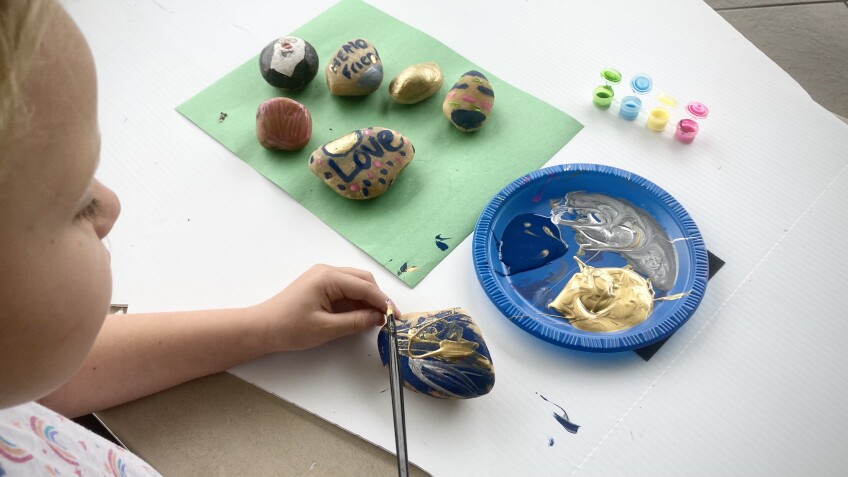How to Make a Community Friendship Rock Garden
It's incredible how preschoolers transform rocks into pets, pretend food or art canvases. Our family seems to have painted rocks scattered all around the house, car and in the depths of purses and backpacks. "So that's why my purse was feeling especially heavy today," I say to myself as I pull out a new rock at the end of the day.
We decided to turn this craft into a fun neighborhood initiative. With a simple sign that says, "Friendship Rock Garden: Take a Rock, Leave a Rock," we swap rocks with positive messages or cute designs between neighbors. My preschooler crafts a unique pattern or smiley face on a rock, and then we have fun placing it in the garden. Each day, we pass by to see if it has been picked up and a new one left in its place.
While it seems simple, this neighborhood exchange helps boost our family's civic and community engagement. PBS KIDS reminds us that "crucial aspects of becoming a good citizen include knowing healthy ways to communicate, interact, and work together."
Here's how to start your own community friendship rock garden.
Learning Goal
- Practice civic engagement and build relationships with neighbors.
- Practice early math skills like patterns, counting, shape recognition, adding and subtracting.
Materials

- Rocks
- Paint and brushes or markers
- A small outdoor space
Step-by-Step Instructions
1. Talk about what it means to be a good neighbor. You might consider watching and singing along to this "What It Means To Be A Good Neighbor" clipfrom "Daniel Tiger's Neighborhood."
2. Find and collect rocks in your neighborhood. Be sure they are found in open, public places. As you walk together, talk about the shapes of the rocks, noticing the difference between an oval and a circle, for example.
3. Using paint or markers, work together to decorate the rocks with encouraging sayings or pictures. Design patterns and use different shapes to boost early math skills. Let them dry.

4. Create a sign that says "Friendship Rock Garden: Take a Rock, Leave a Rock." You might use spare wood, a repurposed yard sign, or paper covered in transparent tape to create a waterproof cover. Then, encourage neighbors to participate in the exchange.
5. Find a small outdoor space for your rock garden, like a lawn, stoop, sidewalk, or local shared community garden. Be sure to ask permission if it is a shared space before starting the garden.
6. Place rocks and the sign in the shared space. Enjoy walking by the garden to see new arrivals. Add math by counting the rocks and using addition and subtraction to see how many rocks there are each time you walk by.

Math Rocks!
Here are even more ways to add early math concepts to your daily activities.
- Map it Out! Use simple directional phrases to describe the location of your garden. Draw a map from your home to the rock garden or another community destination. Add location and position phrases like "next to the stoplight," "across the street" and "behind the tree" to describe the garden's location.
- Sort the Rocks! As friends contribute to the community rock garden, make observations about the rocks' styles, colors and themes. Ask your child to think about how they can sort them based on attributes like size, shape, pattern or color.
- Make Comparisons! Each time you add to the garden, count the number of rocks and talk about if there are more, less, or the same number of rocks as last time. You might use the phrases "fewer" or "greater" in the discussion.
Read Together!
Read about design, neighborhoods and community with these free e-books from the Los Angeles Public Library and PBS KIDS.
- "Little Neighbors: Building a Better World Together" by Sesame Street in Communities shows preschoolers that "the small things we do can all add to big changes … and a better world."

- "Curious George Builds A Home" (Ages 2-6) by H. A. Joe Fallon and Monica Perez explores the concepts of planning and design in a neighborhood. Talk about the design process used in developing the friendship rock garden.

- "Clifford's Good Deeds" (Ages 4-8) by Norman Bridwell shows us that even a big, red dog can support the neighborhood. Talk about how the rock garden contributes to the overall well-being of your neighborhood.

- "Meet the Neighbors!" (Ages 2-5) by Natalie Shaw introduces the friends in Daniel Tiger's Neighborhood of Make-Believe. After reading, think about the neighbors in your community.



